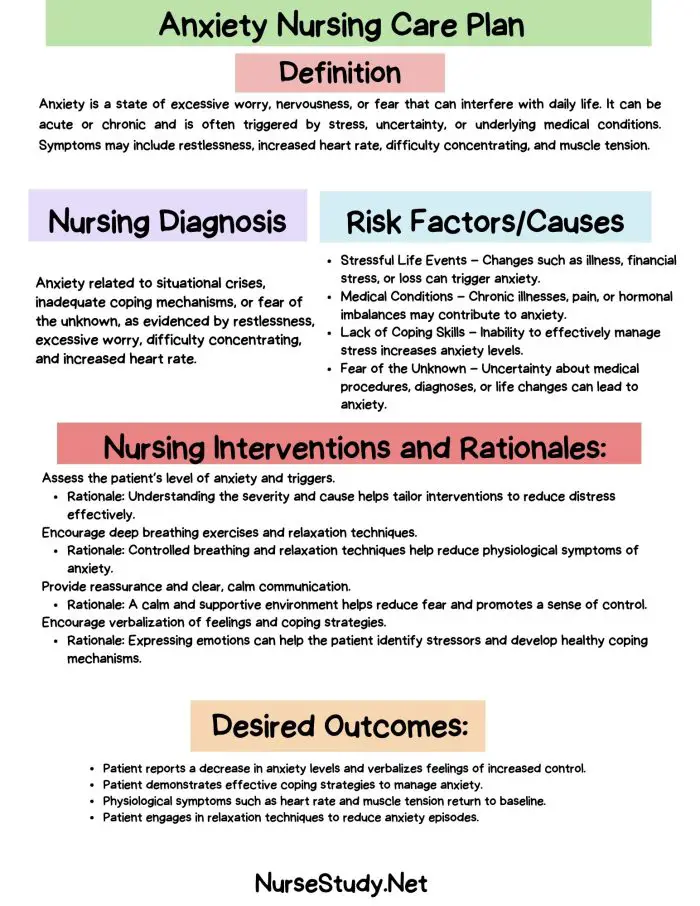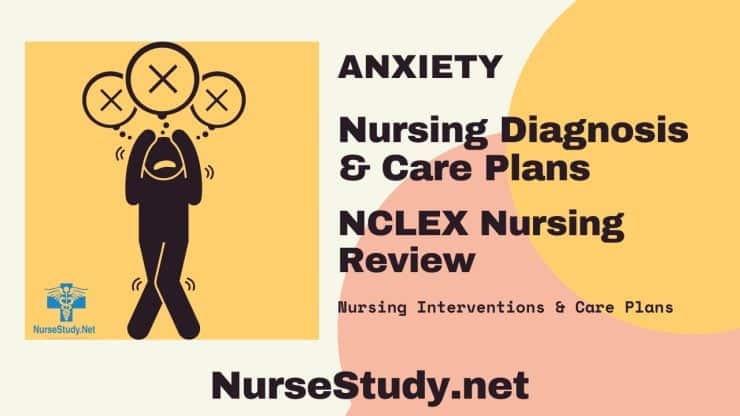Anxiety disorders are characterized by persistent, excessive worry or fear that interferes with daily activities.
The Diagnostic and Statistical Manual of Mental Disorders, Fifth Edition (DSM-5) recognizes several types of anxiety disorders, including:
- Generalized Anxiety Disorder (GAD)
- Panic Disorder
- Social Anxiety Disorder
- Specific Phobias
- Separation Anxiety Disorder
- Agoraphobia
Nurses must be familiar with these different types to assess and diagnose anxiety in their patients accurately.
Causes and Risk Factors
The etiology of anxiety disorders is complex and multifaceted. Common causes and risk factors include:
- Genetic predisposition
- Neurochemical imbalances
- Chronic medical conditions
- Trauma or stressful life events
- Substance abuse
- Environmental factors
- Personality traits
Understanding these factors helps nurses identify at-risk patients and develop targeted interventions.
Signs and Symptoms
Anxiety manifests through various physical, emotional, and behavioral symptoms. Nurses should be vigilant in recognizing these signs:
Subjective Symptoms (Patient Reports):
- Excessive worry or fear
- Restlessness or feeling on edge
- Difficulty concentrating
- Irritability
- Sleep disturbances
Objective Symptoms (Nurse Observes):
- Tachycardia
- Tachypnea
- Diaphoresis
- Trembling or shaking
- Muscle tension
- Hypervigilance
- Avoidance behaviors
Nursing Assessment
A thorough nursing assessment is crucial for diagnosing anxiety and developing an effective care plan. Key components of the assessment include:
- Comprehensive health history
- Physical examination
- Mental status examination
- Anxiety rating scales (e.g., Hamilton Anxiety Rating Scale, Beck Anxiety Inventory)
- Assessment of coping mechanisms and support systems
Nursing Diagnosis Statements
Based on the assessment findings, nurses can formulate appropriate nursing diagnosis statements. Common examples include:
- Anxiety related to situational crisis as evidenced by increased heart rate and verbalization of apprehension
- Ineffective coping related to overwhelming stress as evidenced by inability to problem-solve and social withdrawal
- Disturbed sleep pattern related to anxiety as evidenced by difficulty falling asleep and frequent nighttime awakenings
- Impaired social interaction related to anxiety as evidenced by avoidance of social situations and limited eye contact
- Risk for impaired gas exchange related to hyperventilation secondary to anxiety
Nursing Care Plans
Practical nursing care plans are essential for managing anxiety and improving patient outcomes. Here are five detailed nursing care plans addressing different aspects of anxiety:
Nursing Care Plan 1: Anxiety Management
Nursing Diagnosis Statement: Anxiety related to hospitalization as evidenced by restlessness, increased heart rate, and verbalization of worry.
Related Factors/Causes:
- Unfamiliar hospital environment
- Fear of medical procedures
- Uncertainty about diagnosis and prognosis
Nursing Interventions and Rationales:
- Establish a trusting relationship with the patient through active listening and empathy.
Rationale: A therapeutic relationship promotes a sense of safety and reduces anxiety. - Teach and practice relaxation techniques (e.g., deep breathing, progressive muscle relaxation).
Rationale: These techniques activate the parasympathetic nervous system, reducing physiological anxiety symptoms. - Provide clear, concise information about procedures and treatments.
Rationale: Knowledge reduces uncertainty and enhances the patient’s sense of control. - Administer anti-anxiety medications as prescribed.
Rationale: Pharmacological interventions can help manage severe anxiety symptoms. - Create a calm environment by minimizing noise and disruptions.
Rationale: A peaceful environment promotes relaxation and reduces stress triggers.
Desired Outcomes:
- The patient verbalizes a decrease in anxiety levels within 24 hours.
- The patient demonstrates the use of at least one relaxation technique effectively.
- The patient’s vital signs return to baseline within normal limits.
Nursing Care Plan 2: Ineffective Coping
Nursing Diagnosis Statement: Ineffective coping related to anxiety disorder as evidenced by verbalization of inability to handle stress and social withdrawal.
Related Factors/Causes:
- Limited coping skills
- Overwhelming anxiety symptoms
- Lack of social support
Nursing Interventions and Rationales:
- Assess the patient’s current coping mechanisms and their effectiveness.
Rationale: Identifying ineffective coping strategies allows for targeted interventions. - Teach problem-solving techniques and stress management strategies.
Rationale: Enhancing coping skills empowers patients to manage anxiety more effectively. - Encourage participation in support groups or counseling sessions.
Rationale: Peer support and professional guidance can provide additional coping resources. - Promote healthy lifestyle choices (e.g., regular exercise, balanced diet).
Rationale: Physical health positively impacts mental well-being and stress resilience. - Collaborate with the patient to develop a personalized stress management plan.
Rationale: Patient involvement increases adherence and the likelihood of successful coping.
Desired Outcomes:
- The patient demonstrates using at least two effective coping strategies within one week.
- The patient reports an improved ability to manage stress in daily life.
- The patient engages in social activities without avoidance behaviors.
Nursing Care Plan 3: Disturbed Sleep Pattern
Nursing Diagnosis Statement: Disturbed sleep pattern related to anxiety as evidenced by difficulty falling asleep, frequent nighttime awakenings, and daytime fatigue.
Related Factors/Causes:
- Persistent worry and rumination
- Physiological hyperarousal
- Poor sleep hygiene
Nursing Interventions and Rationales:
- Assess sleep patterns and habits using a sleep diary.
Rationale: Identifying specific sleep disturbances guides targeted interventions. - Educate on sleep hygiene principles (e.g., consistent sleep schedule, bedroom environment optimization).
Rationale: Good sleep hygiene promotes better sleep quality and quantity. - Teach relaxation techniques specifically for bedtime (e.g., guided imagery, mindfulness meditation).
Rationale: Relaxation before sleep can reduce anxiety and promote sleep onset. - Limit caffeine and screen time before bed.
Rationale: These stimulants can interfere with the natural sleep-wake cycle. - Collaborate with healthcare providers to address underlying anxiety through therapy or medication.
Rationale: Treating the root cause of sleep disturbances enhances overall sleep quality.
Desired Outcomes:
- The patient reports improved sleep quality within two weeks.
- The patient demonstrates consistent use of sleep hygiene practices.
- The patient verbalizes reduced anxiety related to sleep difficulties.
Nursing Care Plan 4: Impaired Social Interaction
Nursing Diagnosis Statement: Impaired social interaction related to social anxiety disorder as evidenced by avoidance of social situations and limited verbal communication.
Related Factors/Causes:
- Fear of negative evaluation
- Low self-esteem
- Past negative social experiences
Nursing Interventions and Rationales:
- Assess the extent and impact of social anxiety on daily functioning.
Rationale: Understanding the severity guides appropriate interventions. - Encourage gradual exposure to social situations using a hierarchy approach.
Rationale: Systematic desensitization helps reduce anxiety in social settings over time. - Teach and practice social skills through role-playing exercises.
Rationale: Enhancing social skills builds confidence in social interactions. - Promote positive self-talk and cognitive restructuring techniques.
Rationale: Changing negative thought patterns can reduce social anxiety symptoms. - Refer to cognitive-behavioral therapy (CBT) or group therapy for social anxiety.
Rationale: Evidence-based therapies provide specialized treatment for social anxiety disorder.
Desired Outcomes:
- The patient engages in at least one social activity per week without avoidance.
- The patient demonstrates improved verbal and non-verbal communication skills.
- The patient reports decreased anxiety in social situations within one month.
Nursing Care Plan 5: Risk for Impaired Gas Exchange
Nursing Diagnosis Statement: Risk for impaired gas exchange related to hyperventilation secondary to panic attacks.
Related Factors/Causes:
- Panic disorder diagnosis
- History of hyperventilation during anxiety episodes
- Lack of knowledge about proper breathing techniques
Nursing Interventions and Rationales:
- Assess respiratory rate, depth, and pattern during calm states and anxiety episodes.
Rationale: Establishing a baseline helps identify abnormal breathing patterns. - Teach diaphragmatic breathing and pursed-lip breathing techniques.
Rationale: These techniques promote proper oxygenation and reduce hyperventilation risk. - Provide education on recognizing early signs of hyperventilation.
Rationale: Early intervention can prevent escalation to severe symptoms. - Demonstrate and practice the use of paper bag breathing techniques for acute episodes.
Rationale: This technique helps rebalance oxygen and carbon dioxide levels during hyperventilation. - Collaborate with respiratory therapists for additional breathing exercises if needed.
Rationale: Specialized interventions can address complex breathing issues related to anxiety.
Desired Outcomes:
- The patient maintains a normal respiratory rate and depth during anxiety-provoking situations.
- The patient demonstrates proper use of at least two breathing techniques to manage anxiety symptoms.
- The patient verbalizes an understanding of the relationship between anxiety and breathing patterns.
Evidence-Based Interventions
In addition to the specific interventions outlined in the nursing care plans, several evidence-based strategies have shown effectiveness in managing anxiety:
- Cognitive-Behavioral Therapy (CBT): A structured, short-term form of psychotherapy that helps patients identify and change negative thought patterns and behaviors.
- Mindfulness-Based Stress Reduction (MBSR): A program that combines mindfulness meditation and yoga to reduce stress and anxiety symptoms.
- Exposure Therapy: A technique used to treat specific phobias and social anxiety by gradually exposing patients to anxiety-provoking situations in a controlled environment.
- Pharmacotherapy: Medications such as selective serotonin reuptake inhibitors (SSRIs) and benzodiazepines can be effective in managing anxiety symptoms when prescribed appropriately.
- Exercise: Regular physical activity has been shown to reduce anxiety symptoms and improve overall mental health.
- Complementary Therapies: Techniques such as acupuncture, aromatherapy, and massage therapy may provide additional relief for some patients when used with traditional treatments.
Patient Education
Educating patients about anxiety is crucial for empowering them to manage their symptoms effectively. Key topics to cover include:
- The nature of anxiety and its physiological effects
- Recognizing triggers and early warning signs
- Healthy lifestyle choices that support mental well-being
- Proper use of prescribed medications and potential side effects
- Importance of adherence to treatment plans
- Available community resources and support groups
Conclusion
Anxiety nursing diagnosis requires a comprehensive approach that addresses the multifaceted nature of anxiety disorders. By implementing evidence-based interventions, developing targeted nursing care plans, and providing ongoing support and education, nurses can significantly improve the quality of life for patients struggling with anxiety.
Regular assessment, evaluation, and adjustment of care plans ensure that interventions remain effective and tailored to each patient’s unique needs.
References
- American Psychiatric Association. (2013). Diagnostic and statistical manual of mental disorders (5th ed.). Arlington, VA: American Psychiatric Publishing.
- Bandelow, B., Michaelis, S., & Wedekind, D. (2017). Treatment of anxiety disorders. Dialogues in Clinical Neuroscience, 19(2), 93-107.
- Bystritsky, A., Khalsa, S. S., Cameron, M. E., & Schiffman, J. (2013). Current diagnosis and treatment of anxiety disorders. P & T: A Peer-Reviewed Journal for Formulary Management, 38(1), 30-57.
- Craske, M. G., & Stein, M. B. (2016). Anxiety. The Lancet, 388(10063), 3048-3059.
- Herdman, T. H., & Kamitsuru, S. (Eds.). (2018). NANDA International Nursing Diagnoses: Definitions & Classification 2018-2020. Thieme.
- Locke, A. B., Kirst, N., & Shultz, C. G. (2015). Diagnosis and management of generalized anxiety disorder and panic disorder in adults. American Family Physician, 91(9), 617-624.
- National Institute of Mental Health. (2022). Anxiety Disorders. Retrieved from https://www.nimh.nih.gov/health/topics/anxiety-disorders
- Stein, M. B., & Sareen, J. (2015). Generalized Anxiety Disorder. New England Journal of Medicine, 373(21), 2059-2068.
- Thibaut, F. (2017). Anxiety disorders: a review of current literature. Dialogues in Clinical Neuroscience, 19(2), 87-88.
- World Health Organization. (2017). Depression and Other Common Mental Disorders: Global Health Estimates. Geneva: World Health Organization.

